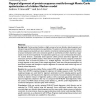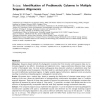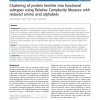8 search results - page 1 / 2 » MSAID: multiple sequence alignment based on a measure of inf... |
CANDC
2005
ACM
13 years 4 months ago
2005
ACM
We propose an algorithm of global multiple sequence alignment that is based on a measure of what we call information discrepancy. The algorithm follows a progressive alignment ite...
RECOMB
2003
Springer
14 years 4 months ago
2003
Springer
We describe a novel method for detecting the domain structure of a protein from sequence information alone. The method is based on analyzing multiple sequence alignments that are ...
BMCBI
2004
13 years 4 months ago
2004
Background: Certain protein families are highly conserved across distantly related organisms and belong to large and functionally diverse superfamilies. The patterns of conservati...
ALMOB
2008
13 years 4 months ago
2008
Motivation: Sequence-based methods for phylogenetic reconstruction from (nucleic acid) sequence data are notoriously plagued by two effects: homoplasies and alignment errors. Larg...
BMCBI
2010
13 years 4 months ago
2010
Background: Phylogenetic analysis can be used to divide a protein family into subfamilies in the absence of experimental information. Most phylogenetic analysis methods utilize mu...



